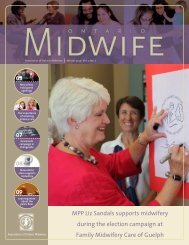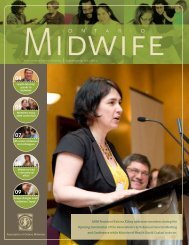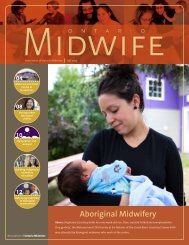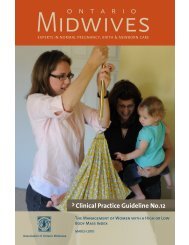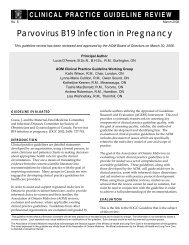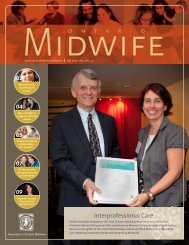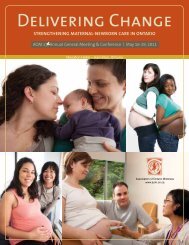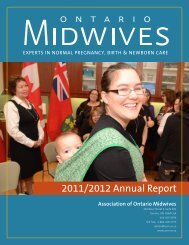AOM News & UpdatesCelebrating 15 years <strong>of</strong> regulated midwifery in <strong>Ontario</strong>Anita Rutherford was the first midwiferyclient to give birth in an <strong>Ontario</strong> hospitalattended by midwives instead <strong>of</strong> a doctorafter regulation came into place inJanuary 1994. Baby Rebecca arrived justone day after Registered Midwife CarolCameron and six other midwives weregranted privileges at the hospital.“There was a lot <strong>of</strong> excitement goingon behind the scenes,” says Cameron.“All these people were waiting outsidethe room and we weren’t even aware<strong>of</strong> it until after the birth. There was anews camera, the Hospital Chief <strong>of</strong> Staff,and Anita was so gracious and spoke toeveryone. I’m glad it was her fourth babyand everything was straightforward.”“Baby” Rebecca is now a teenagercelebrating her fifteenth birthday rightalong with midwifery in <strong>Ontario</strong>.Provincial midwifery legislation waspassed in 1991, but didn’t take effect untilthe first day <strong>of</strong> 1994.At that time, 60 midwives were registeredto practice in <strong>Ontario</strong>. Today, there areover 400 and that number is expected todouble in the next four years.Of the “original sixty” midwives whoqualified to practice through theMichener Program, thirty-five arecurrently registered with the AOM.Today, there are 66 practices operating 73sites across the province.Cameron, a former AOM President, saysregulation changed how midwives areviewed in the health care system.“It sounds cliché, but it’s huge. Whenyou’re outside the system, you caninfluence individuals, but now in terms<strong>of</strong> hospitals, I sit on multidisciplinarycommittees, I’m the head midwife at thehospital and maternity policy decisionshave to include midwives. People lookto me for my expertise and experience.It’s counted and valued. Now we haveinfluence for women in the communityand the pr<strong>of</strong>ession.”But she recognizes that regulation didn’tfix everything overnight.“Change is hard for anybody,” saysCameron. “People are vulnerable abouttheir roles. It can be difficult to negotiatethe role definitions – we’re alwaysworking on that with doctors and nursesand midwives. It takes goodwill on allsides and really working together for awhile at any site.”Besides pr<strong>of</strong>essional changes, regulationgave Cameron personal rewards as well.“Now I can truly provide the kind <strong>of</strong> carethat in the past I was just advocating for,”Top: Rebecca Rutherford, Carol Cameron, RM, and AnitaRutherford hold clippings from the January 29, 1994Toronto Star. Rebecca’s birth at Markham-StouffvilleHospital was front page news.Bottom: Anita, Rebecca and Carol enjoy birthday cakeand a reunion at the photo shoot.Photos by Ian Goodallshe says. “Being a primary care providermeans the client and the pr<strong>of</strong>essionalcome up with a care plan and see it rightthrough. Even if other care providers areinvolved, you’re orchestrating it. That’s asource <strong>of</strong> personal satisfaction and pride.”“At this point in my career, it’s also sosatisfying that I’m helping the futuregenerations. I love working with MEPstudents and IMPP midwives andmentoring them,” she says. “Beingable to see the future is personally veryrewarding.”06ontario midwife • <strong>Winter</strong> <strong>2009</strong>
Key Maternity Care IssuesPassion and hard work key to starting a new practiceEstablishing a new practice takes a lot<strong>of</strong> hard work and organization, but therewards are enormous both to practicepartners and families in the community.Midwifery continues to grow at atremendous rate in <strong>Ontario</strong>. Consumerdemand is high, and more midwives enterthe pr<strong>of</strong>ession every year than retire. Thismeans that individual midwives have to beleaders in expandingopportunities topractice.One way to start anew practice is bya satellite location“splitting” <strong>of</strong>f anddividing a catchmentarea. <strong>Midwives</strong> <strong>of</strong>Grey Bruce havedone this a few times.“In the late ‘90s we had huge catchmentarea and we had grown to have elevenmidwives,” says Heather Keffer, a founder<strong>of</strong> Grey Bruce (previously Grey Simcoe).“So it made sense that in 2001, once wehad enough midwives living near theBarrie area, we had our amicable divideand the satellite clinic there became aseparate practice. Recently, the samething happened again and the clinic inCollingwood became a new practice andthe Grey Bruce practice set up in OwenSound, which used to be a satellite <strong>of</strong>fice.”The original practice, Grey Bruce, continuesto provide support for the new practice.“Un<strong>of</strong>ficially, we provide backup for thenew Nottawasaga practice because thereare only two midwives,” says Keffer. “Weretain hospital privileges in Collingwood,but haven’t had to use them yet.”Lynne- Marie Culliton is a partner atNottawasaga. “Two major advantages <strong>of</strong>starting a new practice in an establishedclinic are that you already have a built-incaseload and location. We also alreadyhad hospital privileges, so that made thetransition in the community quite smooth.”Internally, though, starting a new practicemeans a lot <strong>of</strong> changes. “One <strong>of</strong> thebiggest disadvantages was going from abig practice with eight full time midwivesand an administrator to a small one withonly two midwives and no administrator.All <strong>of</strong> the systems – charts, call schedule,clinic schedule, <strong>of</strong>fice procedures and suchworked well for a big group, but not for asmall group. It has meant a lot <strong>of</strong> reworkingthings to fit better with the resources wehave,” says Culliton.Some midwives start new practices in areaspreviously underserviced by midwiferycare, or where they have their own roots inthe community, but where no clinic currentexists. Starting from scratch <strong>of</strong>fers its ownchallenges and its ownrewards.“My intention rightout <strong>of</strong> school was toopen a practice in myhome community,” saysLisa Weston <strong>of</strong> Sages-Femmes Rouge Valley<strong>Midwives</strong>. “We wereworking on it during ournew registrant year.”There was a strong group <strong>of</strong> about 15consumers working with the future RougeValley <strong>Midwives</strong> during the proposal stageand beyond.“Three <strong>of</strong> us worked out <strong>of</strong> our homes andcars for about a year in 2004, but nowwe’ve grown to have eight midwives and apermanent clinic space,” says Weston. “I’mgrateful to those midwives who gave us somuch support and mentoring during ourfirst years. It was a steep learning curve,so it was important to have their help andhave different viewpoints from a few otherpractices, and from the <strong>Association</strong>. Thesedays, there are even more resources inplace for midwives interested in starting anew practice.”“Starting from zero meant a huge amount<strong>of</strong> work and responsibility, but there’salso joy in making our own vision andour model a reality,” she says. “It mightbe easier to start from a satellite in someways but there may be limitations interms <strong>of</strong> how you want to organize andpractice. We created the identity andflavor <strong>of</strong> our practice and set things upthe way we wanted right from the start,rather than having to un-do any previousarrangements.”Whether starting from an establishedsatellite site or a brand new practice, everynew practice must go through regularapplication channels with the Ministry <strong>of</strong>Health and Long-Term Care.New practices based ondemand, existing service,practice group strategyThe first step in starting a new practiceis to contact the <strong>Ontario</strong> MidwiferyProgram (OMP) at the Ministry <strong>of</strong>Health. The OMP holds an annual informationsession each fall (November),but your work can and should beginbefore then. Proposals are usually duein January. The AOM can provide ideasand advice about the process.Steps in Proposal Development1. Establish a location and assessstakeholder support2. Review proposal guidelines,conduct research and assemblenecessary resources3. Develop and draft proposalincluding a proposed budget4. Submit proposal to the TransferPayment Agency (TPA)5. Refine proposal with TPA6. TPA approves proposal andsubmits to OMP with TPA AnnualBudget RequestExpansion CriteriaThe OMP uses the following criteriato determine whether to expand orestablish midwifery services:• Under-served community –Priority given to communities withobstetrical provider shortages• Strong unmet demand formidwifery services in thecommunity• Practice group efficiency –strategy ensures that practicegroups function at adequate sizeto provide on-call coverage.Resources:• AOM• OMP• TPAs• Hospitals• Current practice• Neighbouring practices• Community Health Centres• Consumer Advocacy Groupswww.aom.on.ca07




